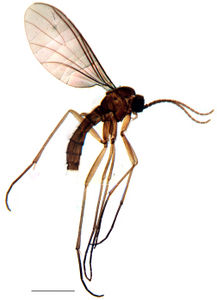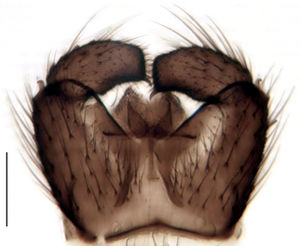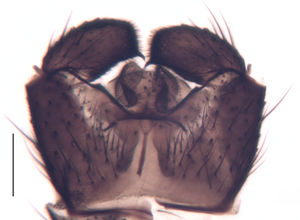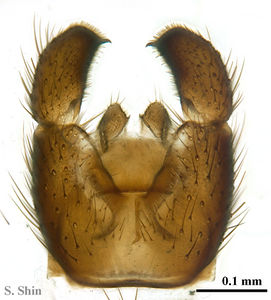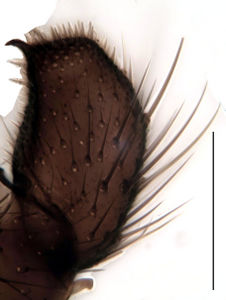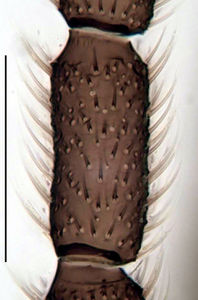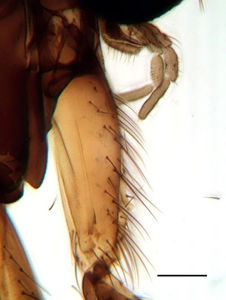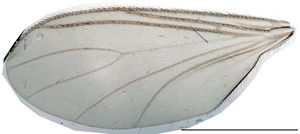Trichosiopsis finjae
Ordo: Diptera
Familia: Sciaridae
Genus: Trichosiopsis
Name
Trichosiopsis finjae unpublished
Type material
Holotype: ♂, 10.07.2013, sweep netting, leg. Heller, ZFMK-TIS-14911 in ZFMK
Type locality
Germany, Schleswig-Holstein, Bilsen, Bilsener Wohld
Other material studied
Austria: 1 ♂, Styria, Gesäuse Nationalpark, Hartelsgraben, Handhabenhöhlenquelle, emergence trap, Gerecke, 05.07.2008, PKHH 7112 [as Leptosciarella rejecta in Heller (2012[1]: 378)]; Denmark: 1 ♂, Kalø, Hestehaven, beech forest, photoeclector, Nielsen, 01.06.1993, PKHH 8726; 2 ♂, 11.06.1993, PKHH 8732; 2 ♂, 02.08.1993, PKHH 8724/8725; France: 1 ♂, Marais de Lavours, bois humide, Malaise trap, Withers, 4.-14.06.2009, PPWM 55; 1 ♂, 9.-15.06.2011, PPWM 53; 1 ♂, 14.-21.06.2011, PPWM 52; 1 ♂, Saint-Jean-de-Turigneux, foumiliere, Malaise trap, Withers, 05.06.2007, PPWM 54; Germany: 1 ♂, Baden-Württemberg, Mössingen, Hirschkopf, Quelle Hi 3, Buchenwald westlich des Bergrutschs, sweep netting, Gerecke & Bückle, 09.05.2011, PKHH 7924; 1 ♂, Mecklenburg-Vorpommern, Elisenhain b. Greifswald, Laubwald: Buche, Eiche, sweep netting, Jaschhof, 10.05.1994, PWMP 4039; 1 ♂, Buchenwald, Mohrig, 01.06.1984, PWMP 1625 [all previous material from PWMP as Leptosciarella rejecta (partim) in Mohrig & Menzel (1997[2]: 63)]; 2 ♂, Greifswald, Laubwald, Malaise trap, Jaschhof, 1994, PKHH 5448; 1 ♂, NSG Galenbecker See, Grünland Rasenschmielen-, Quecken-, Kohldistel-, Staudenflora, photoeclector, Jaschhof, 29.8.-10.10.1994, PWMP 1648; 1 ♂, PWMP 4038; 4 ♂, North-Rhine-Westphalia, Ubbedissen, Buchenwald, sweep netting, Heller, 12.06.2004, PKHH 4209/4210; 2 ♂, Rhineland-Palatinate, Gönnersdorf (Eifel), Mäuerchenberg Trockenrasen, Malaise trap, Cölln, 1.-08.06.1991, PKHH 1879 [as Leptosciarella scutellata (partim) in Heller (1999[3]: 256); 1 ♂, Saxony, Streitwald, vegetationsreicher Mischwald, sweep netting, Heller, 17.06.2012, PKHH 8020; 1 ♂, Saxony-Anhalt, Rübeland, Blauer See, Mischwald aus Fichte und Bergahorn, sweep netting, Heller, 09.06.2001, PKHH 3422 [as Leptosciarella rejecta in Menzel et al. (2002[4]: 184)]; 1 ♂, Schleswig-Holstein, 1 ♂, Sterley, sweep netting, Heller, 17.05.2003, PKHH 3982; 3 ♂, Thuringia, NSG Sonder b. Schlotheim, Hanfsee, Kesselmoor (Birke), Menzel, 28.05.1988, PWMP 1628[as Leptosciarella rejecta (partim) in Mohrig & Menzel (1997[2]: 63)]; 2 ♂, Rabis b. Jena, Trockenhang, sweep netting, Jaschhof, 26.06.1993, PWMP 4040/4041; Italy: 1 ♂,South Tyrol, Stilfzer Joch NP, Suldental bei Schmelz, montaner Fichtenwald, Malaise trap, Lange & Ziegler, 25.7.-01.08.2005, SDEI 3356; Norway: 2 ♂, Sogn og Fjordane, Sogndal, Navarsete, Rinderweide mit Gebüsch, sweep netting, Gammelmo & Olsen, 04.06.2014, PKHH 8578; 1 ♂, W Steig, Laubwald in Hanglage, sweep netting, Heller, 05.06.2014, PKHH 8427; Sweden: 13 ♂, Skåne, Simrishamn, Stenshuvud National Park: Svabeholmsskog, hornbeam forest, Malaise trap, Swedish Malaise Trap, 22.5.-20.06.2005, PKHH 7238; 5 ♂, Södermanland, Södertälje, Tullgarns näs, Rävsalaviken, mixed forest next to pasture, Malaise trap, Swedish Malaise Trap Project, 3.7.-19.08.2004, PKHH 7485; 2 ♂, Västerbotten, Skellefteå, Brännbergets naturreservat, mixed boreal forest, Malaise trap, Swedish Malaise Trap Project, 21.7.-12.08.2004, PKHH 7294; Russia: 1 ♂, Altai, Artybasch, dichter Nadelwald Nähe Schuttplatz, sweep netting, Heller, 03.07.2005, PKHH 4433; 1 ♂, Krasnodarsky Kray. Sochi, Mt. Akun, Hippa, 05.1988, MZH 9394; Switzerland: 1 ♂,Zurich, Sihlwald, window trap, Schiegg, 20.6.-08.07.1996, PKHH 1788;
Description (male)
Head. Eye bridge 4–5 rows of facets. Antenna unicolour. LW-index of 4th flagellomere 1.9–2.4; neck 0.28–3.4 × segment width; transition of basal part to neck pronounced. Colour of neck unicolour. Antennal setae shorter than segment width; of normal strength; sparse. Palpus darkened; short, or of normal length; palpomeres 3. First palpomere of normal shape, or thickened; with 5–8 setae; with only sparse sensilla. Second palpomere short and oval. Third palpomere as long as first. Thorax. Colour brown. Notum unicolour. Thoracic setae normal; black. Posterior pronotum setose. Postpronotal setae 2–5. Mesothoracic sclerites bare. Legs. Colour yellow-brown. Hind coxa darkened. Setae on front coxa black. Front tibial organ as patch of setae; dark; front tibial organ not bordered. Tibial setae on hind legs normal, shorter than tibial width. Tibial spurs of equal length. Claws untoothed. Wing. Wing slightly darkened; of normal shape. Wing membrane without macrotrichia. Wing venation weak, with faint stM. M-fork of normal shape. R1 ending at or slightly before base of m-fork; posterior veins with macrotrichia; stM mostly with macrotrichia; CuA1 and CuA2 mostly with macrotrichia; bM bare; r-m with few setae; bM:r-M 1.05–1.3; st-Cu:bM 0.3–0.45; R1:R 1.7–1.95; c:w 0.6–0.75. Halter darkened; of normal length. Abdomen. Abdominal setae strong; on tergites black; on sternites black. Hypopygium concolour with abdomen; LW-index 0.6–0.75. Base of gonocoxites with strong setae; gonocoxites broadly separated; inner margin of gonocoxites typically U-shaped; inner membrane of hypopygium scarcely setose; ventral margin of gonocoxite with short setae. Gonostylus elongate; LW-index 1.8–2.1; Inner margin straight, or concave; apex with one obtuse angle. Apical tooth present; without internal structure; strong; LW-Index 2.1–2.6. Awl-like setae normal; present beneath apical tooth. Megasetae absent. Whiplash-hair absent. Tegmen 0.65–0.8 × longer than broad; rectangular with rounded edges; without special features; central process absent. Length of ejaculatory apodeme/hypopygium 25–35 %; base of ejaculatory apodeme absent. Field with aedeagal teeth inconspicuous. Measurements. Body size 2.7–3.2 mm. Hind tibia 1.45–1.6 mm. Wing length 2.5–3 mm.
Diagnosis
The species is placed in the Trichosiopsis rejecta group and can be distinguished from other, similar species by the combination of the following characters: strong setae at the base of the gonocoxites, strong and black setae at the fore coxae, legs darkened, gonostylus thick and short, apically with an obtuse apico-dorsal angle, posterior pronotum setose. The thick and relatively short gonostylus and the small size seem to be reliable characters. Care must be taken for distinguishing the similar species Trichosiopsis scutellata and Trichosiopsis coloniae.
DNA Barcoding
The COI sequences are assigned to three different BINs:
- BIN BOLD:ACP7122 (average distance 0.44%, max. 1.62%, n=20, K2P: 1.77%)
- BIN BOLD:ACU4807 (average distance 0.44%, max. 0.15%, n=12, K2P: 1.77%)
- BIN BOLD:ACD6178 (n=1, K2P: 5.62%)
Etymology
The species is named after the young student Finja Westphal from Hamburg, as an incentive for future scientific effort.
Discussion
Trichosiopsis finjae is one of the most common species of the genus Trichosiopsis in Central Europe. It was formerly included in the collective species Tr. rejecta by Mohrig & Menzel (1997[2]). Later it was distinguished from Tr. rejecta by the darker legs and the black setae at the fore coxae and preliminarily treated as Leptosciarella echinata on Species-ID. Although the barcoding sequence clearly separates Tr. finjae from other similar species, the morphological identification remains challenging as well as the intraspecific allocation to one of the subgenera.
Distribution
Austria, Denmark, France, Germany, Italy, Korea, Norway, Russia, Sweden, Switzerland.
Subspecies list
Trichosiopsis finjae anoukae - Trichosiopsis finjae finjae - Trichosiopsis finjae suzyae
Images
|
References
- ↑ Heller, K. 2012: IV 6.3 Familie Sciaridae (Trauermücken). In: R. Gerecke, H. Haseke, J. Klauber, & A. Maringer (Eds), Quellen, Schriften des Nationalparks Gesäuse 7. Weng im Gesäuse. 189–199, 373–381.
- ↑ 2.0 2.1 2.2 Mohrig, W.; Menzel, F. 1997: Revision der paläarktischen Arten von Trichosia Winnertz sensu Tuomikoski, 1960 (Diptera, Sciaridae). – Teil II. Gattungen Leptosciarella Tuomikoski, 1960 und Trichodapus gen. nov. Studia dipterologica, 4(1), 41–98.
- ↑ Heller, K. 1999: Trauermücken (Diptera: Sciaridae) von Gönnersdorf (Kr. Daun). Beiträge zur Insektenfauna der Eifeldorfer 20. Dendrocopos, 26, 249-262.
- ↑ Menzel, F.; Heller, K.; Smith, J.E. 2002: Neue Trauermücken-Nachweise (Diptera: Sciaridae) aus dem Harz nebst der Beschreibung einer neuen Bradysia-Art. Studia dipterologica, 9, 179–189.
